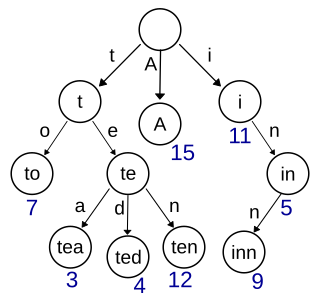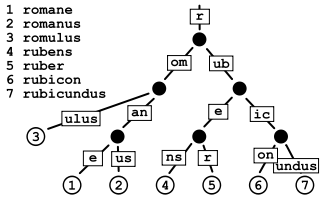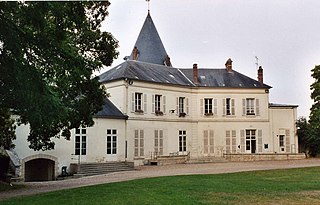Related Research Articles

In computer science, a trie, also called digital tree or prefix tree, is a type of search tree, a tree data structure used for locating specific keys from within a set. These keys are most often strings, with links between nodes defined not by the entire key, but by individual characters. In order to access a key, the trie is traversed depth-first, following the links between nodes, which represent each character in the key.

In computer science, a suffix tree is a compressed trie containing all the suffixes of the given text as their keys and positions in the text as their values. Suffix trees allow particularly fast implementations of many important string operations.

Gisors is a commune of Normandy, France. It is located 62.9 km (39.1 mi) northwest from the centre of Paris.

In computer science, a radix tree is a data structure that represents a space-optimized trie in which each node that is the only child is merged with its parent. The result is that the number of children of every internal node is at most the radix r of the radix tree, where r is a positive integer and a power x of 2, having x ≥ 1. Unlike regular trees, edges can be labeled with sequences of elements as well as single elements. This makes radix trees much more efficient for small sets and for sets of strings that share long prefixes.
In computer science, a ternary search tree is a type of trie where nodes are arranged in a manner similar to a binary search tree, but with up to three children rather than the binary tree's limit of two. Like other prefix trees, a ternary search tree can be used as an associative map structure with the ability for incremental string search. However, ternary search trees are more space efficient compared to standard prefix trees, at the cost of speed. Common applications for ternary search trees include spell-checking and auto-completion.
In computer science, a Levenshtein automaton for a string w and a number n is a finite state automaton that can recognize the set of all strings whose Levenshtein distance from w is at most n. That is, a string x is in the formal language recognized by the Levenshtein automaton if and only if x can be transformed into w by at most n single-character insertions, deletions, and substitutions.

In computer science, a deterministic acyclic finite state automaton (DAFSA), also called a directed acyclic word graph is a data structure that represents a set of strings, and allows for a query operation that tests whether a given string belongs to the set in time proportional to its length. Algorithms exist to construct and maintain such automata, while keeping them minimal.

Sainte-Trie is a commune in the Dordogne department in Nouvelle-Aquitaine in southwestern France.

Trie-sur-Baïse is a commune in the Hautes-Pyrénées department in south-western France. It is the administrative center in a canton comprising 22 villages. It is famous for its annual pig festival known as La Pourcailhade.

Trie-Château is a commune in the Oise department in northern France. On 1 January 2018, the former commune of Villers-sur-Trie was merged into Trie-Château.

Toeufles is a commune in the Somme department in Hauts-de-France in northern France.
Jean II de Trie was the first of his name and second of his house to be Count of Dammartin. He succeeded his father, Mathieu, in Dammartin and as lord of Trie and Mouchy, on the latter's death in 1272. He is the same person as the trouvère Jehan de Trie, to whom two surviving chansons courtoises have been attributed. One of these, Bone dame me prie de chanter, is also sometimes attributed to Theobald I of Navarre or Gace Brulé. The other, Li lons consirs et la grans volentés, is undisputed. Both are isometric, decasyllabic, Dorian and set in bar form, and begin with the leading-tone. At one place in Bone dame there occurs the highly unusual octave leap downwards.
In computer science, an x-fast trie is a data structure for storing integers from a bounded domain. It supports exact and predecessor or successor queries in time O(log log M), using O(n log M) space, where n is the number of stored values and M is the maximum value in the domain. The structure was proposed by Dan Willard in 1982, along with the more complicated y-fast trie, as a way to improve the space usage of van Emde Boas trees, while retaining the O(log log M) query time.
In computer science, a y-fast trie is a data structure for storing integers from a bounded domain. It supports exact and predecessor or successor queries in time O(log log M), using O(n) space, where n is the number of stored values and M is the maximum value in the domain. The structure was proposed by Dan Willard in 1982 to decrease the O(n log M) space used by an x-fast trie.
A concurrent hash-trie or Ctrie is a concurrent thread-safe lock-free implementation of a hash array mapped trie. It is used to implement the concurrent map abstraction. It has particularly scalable concurrent insert and remove operations and is memory-efficient. It is the first known concurrent data-structure that supports O(1), atomic, lock-free snapshots.

The Wavelet Tree is a succinct data structure to store strings in compressed space. It generalizes the and operations defined on bitvectors to arbitrary alphabets.
In computer science, a hash tree is a persistent data structure that can be used to implement sets and maps, intended to replace hash tables in purely functional programming. In its basic form, a hash tree stores the hashes of its keys, regarded as strings of bits, in a trie, with the actual keys and (optional) values stored at the trie's "final" nodes.
The Counts of Dammartin were the rulers of the county of Dammartin, based in the current commune of Dammartin-en-Goële as early as the 10th century. Located at the central plain of France, the county controlled the roads of Paris to Soissons and Laon. It seems that this county was initially held by Constance, the wife of Manasses Calvus, the first Count. The name Dammartin-en-Goële comes from Domnus Martinus, the Latin name of St. Martin of Tours, who evangelized the region of Goële in the fourth century. A small town in the district of Meaux in the Department of Seine-et-Marne, ancient village of Region of Île-de-France, it appears to go back to the earliest times; Dammartin-en-Goële, also called Velly, was in 1031 one of the most significant places in France.
The canton of Les Coteaux is an administrative division of the Hautes-Pyrénées department, southwestern France. It was created at the French canton reorganisation which came into effect in March 2015. Its seat is in Trie-sur-Baïse.